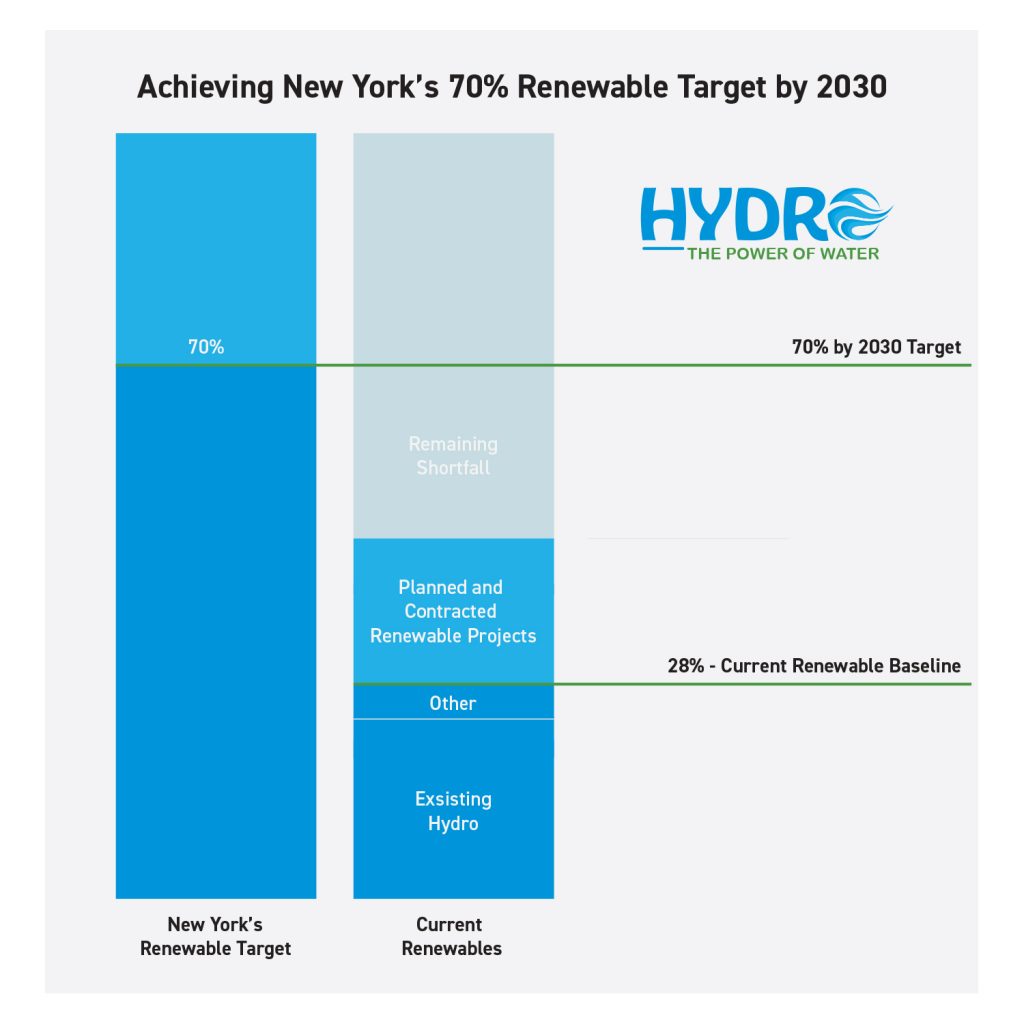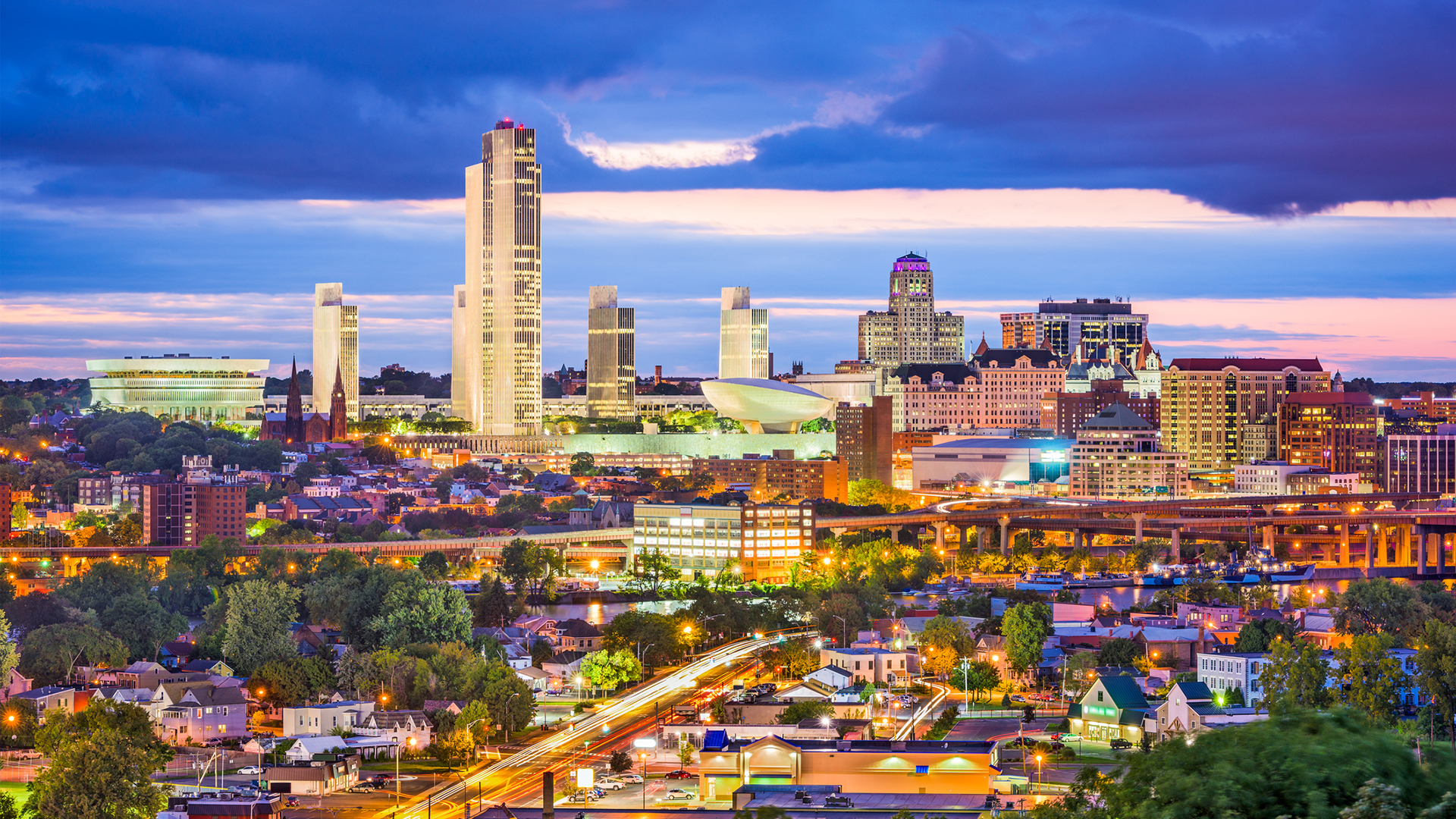Why does New York need more clean energy infrastructure?
By 2030, the state law known as the Climate Leadership and Community Protection Act or CLCPA will require that New York meet 70% of its power needs with renewable energy. By 2040, New York must generate 100% of its electricity with carbon-free energy. Yet today in 2021, for a state of 20 million people, New York only meets roughly 25% of its needs with renewables. Of that 25%, hydropower makes up nearly 80% – the vast majority of the state’s renewable power generation. In December 2020, non-hydro power renewables only comprised 6% of New York’s electricity mix, according to federal data. To meet these ambitious requirements in such a short amount of time, for a state as large as New York will be extremely challenging without more options that provide large quantities of clean power.
To meet this ambitious future, the state has also required:
• 6,000 megawatts (MW) of solar by 2025
• 3,000 megawatts (MW) of energy storage by 2030
• 9,000 megawatts (MW) of offshore wind by 2035
Renewable development doesn’t happen overnight. In fact, the Solar Energy Industry Association (SEIA) estimates that if everything goes as planned, projects can take between three to five years. That’s assuming there is full community support and no project opposition. And there are challenges to consider, like where they will be located, how much land will be required to generate the power needed, navigating the unpredictable regulatory and permitting processes, including interconnecting projects to the existing transmission grid and working with communities that may be affected by the construction and operating impacts. Regardless of the energy type, infrastructure projects are prone to delay and litigation, adding to the development timeline.
So, how do we get to where we need to be by 2030? The answer is becoming clearer – New York’s future energy portfolio needs to incorporate large-scale hydropower solutions to have a chance to meet its CLCPA requirements.
What is New York’s current energy mix? Can hydropower help meet the state’s requirements?
New York is quite a dichotomy in and of itself, with large volumes of renewables used upstate while 70% of downstate power is provided by traditional fuel. Further, natural gas, nuclear power, and hydroelectricity have provided more than nine-tenths of the state’s net electricity generation since 2012, and other renewable resources have provided the rest. Five of the state’s 10 largest power plants are natural gas-fired, and more than half of New York’s generating capacity is from natural gas-fired power plants. Outside of natural gas, about one-third of New York’s electricity came from nuclear power in 2019.
New York is perfectly situated to expand the use of hydro along with other promising clean energy technologies if it plans to balance its energy resources to provide power to New Yorkers downstate. Roughly 20% of New York’s power generation comes from hydropower and generates more power from hydro than any state east of the Rocky Mountains. New York also has robust imports of Canadian hydropower that provide 5% of the state’s electric demand and 20% of its renewable energy needs. In December 2020, nearly 80% of New York’s renewable power came from existing hydropower, and non-hydro renewables only accounted for 6% of the state’s electricity over that same period.
In general, the use of hydropower and other non-hydro power renewables is confined to the upstate and western portions of the state. Bottlenecks on the transmission system prevent the delivery of these low emissions to downstate areas including New York City, where consumers rely on fossil fuel-based electricity for nearly 70% of its supply.
In addition to the new climate requirements, a significant portion of New York’s existing nuclear fleet is expected to go offline – meaning the state will need significantly more clean energy to meet its goals. For example, in April 2021, New York City will lose roughly one-third of the Downstate region’s power needs, and its largest source of emissions-free power, when the Indian Point nuclear power plant closes. This closure will increase New York City’s reliance on fossil fuels for electricity to nearly 100%.
That means New York has less than nine years to generate 70% of its electricity with renewable energy. Today, that number stands at roughly 25% with nearly 80% of that figure coming from New York’s existing hydropower. New York needs an “all-of-the-above” approach, which includes all clean technologies. Large-scale hydropower will complement the buildout and optimization of wind and solar power. As an always-on option for consumers, it supports increased quantities of intermittent resources.
Can we meet New York’s requirements by simply adding more renewable energy?
 Meeting New York’s ambitious renewable generation and emissions targets will be a massive undertaking. Federal data showed that New York’s non-hydro renewable power generation in December 2020 was only 6%. Even if all of New York’s proposed and contracted wind and solar projects come online with no delays, there will still be a substantial shortfall to meet the state’s 70% renewable power requirement by 2030. The New York State Energy Research and Development Authority (NYSERDA) and the New York Department of Public Service estimated this shortfall to be over 24,000 gigawatt-hours per year, which is nearly 17% of the expected electricity load for the entire state in 2030.
Meeting New York’s ambitious renewable generation and emissions targets will be a massive undertaking. Federal data showed that New York’s non-hydro renewable power generation in December 2020 was only 6%. Even if all of New York’s proposed and contracted wind and solar projects come online with no delays, there will still be a substantial shortfall to meet the state’s 70% renewable power requirement by 2030. The New York State Energy Research and Development Authority (NYSERDA) and the New York Department of Public Service estimated this shortfall to be over 24,000 gigawatt-hours per year, which is nearly 17% of the expected electricity load for the entire state in 2030.
New York’s offshore wind and solar developments are a promising start, but the fact remains that many of these projects will take several years to permit and come to fruition. Even if we tried to meet New York’s requirements with renewable projects and removed the uncertainty around building them (including the time needed for federal and state environmental reviews and mitigation plans, permits, and much more) it will still be a challenge.
Studies show onshore utility-scale renewable power projects require at least 10 times more land area as compared with traditional fossil fuel-based generating technologies because of energy density issues. With that in mind, consider that more than half of the state of New York is occupied by forest and woodland, and farmland accounts for nearly one-quarter of the total land area. Not to mention the significant density in New York City and Long Island. To reduce drag and turbulence, onshore wind farms need significant amounts of space between turbines. A standard rotor diameter of a turbine is roughly 260 feet and it needs approximately seven rotor diameters of spacing. To account for equipment and proper spacing between panels, a 1-megawatt solar farm typically needs 6–8 acres, according to GTM Research.
Meeting just 50% of New York’s renewable generation by 2030 – not the 70% mandated by CLCPA – with onshore solar and wind would require an estimated 323 square miles of land – the equivalent size of Seneca County. This equivalency estimate also assumes an apple-to-apples comparison with the generating efficiency of an always-on source of power generation, which renewables by themselves are not capable of offering. In addition, it does not take into account the tremendous amounts of land that will be needed for siting New York’s first offshore wind projects.
For example, the world’s largest offshore wind farm in the United Kingdom requires 892 square miles of ocean. Currently, the US has only one offshore wind farm, which is a 30-megawatt project off the coast of Rhode Island; by comparison, New York intends to site 9,000 megawatts. Each of these examples illustrates the vast amount of space needed in a state with many competing interests.
If New York ever has a hope of meeting its CLCPA requirements, the quickest and most cost-effective way to bring on substantial supplies of emissions-free energy in the near term is supporting additional transmission for hydro. That’s a guarantee for households they will have always-on power that can help integrate and optimize the other long-term renewable energy options and technologies.
What is the benefit of hydropower for New York and its consumers?
Hydropower is a proven and near-term renewable solution for New York to ensure the state has enough affordable, reliable energy supplies available to maintain the grid with enough clean energy to power the lives of families, small businesses, and communities. The following benefits make hydropower a sensible, realistic, and environmentally responsible solution to New York’s energy future:
- Hydropower is one of the lowest emission-generating options available anywhere on par with nuclear and wind.
- At US $0.05/kWh, hydroelectricity remains the lowest-cost source of electricity worldwide.
- Hydropower rates are stable and are not subject to the price volatility of commodities.
- Reservoir hydro is a renewable resource capable of providing baseload (like nuclear) and load following (like natural gas) –it has the advantage of being “always-on” and can offer continuous generation.
- It can help to be a clean energy replacement for retiring baseload generation and it to help back up other intermittent sources of electricity like solar or wind.
- Large-scale hydropower can complement the buildout and optimization of additional wind and solar power for the grid, which have lower capacity, factors because the wind is not always blowing, and the sun is not always shining.
- In fact, a single, new, large-scale transmission project between Quebec and NYC could provide over 33% of the remaining renewable energy needed to achieve New York’s 2030 renewable energy target based on recent estimates by NYSERDA and the NY Department of Public Service. This is especially important as the largest emissions-free source of electricity in Downstate New York is going offline in April 2021.
You can download the Power of Water – New York – FAQs

